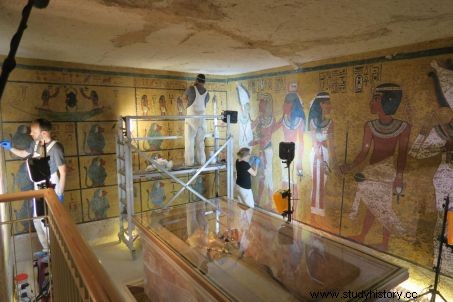Los Angeles' Getty Conservation Institute, which has just completed restoration work at Egypt's most famous tomb, reveals the mysterious brown stains riddled with ornate walls are microbiological in origin, but the organisms are dead , and that they are no longer a threat.

The wall paintings of Tutankhamun's tomb are dotted with brown spots.
Since 1922, the year of its spectacular discovery by Englishman Howard Carter, the tomb of Tutankhamun, the most illustrious of the pharaohs in the Valley of the Kings, near Luxor (Egypt), has been constantly scrutinized. While the results of the latest ground-penetrating radar surveys carried out in February 2018 by an Italian team from the Polytechnic of Turin are eagerly awaited, in search of a possible unknown part, we learn that American specialists from the Getty Conservation Institute (GCI), in Los Angeles, are completing, in collaboration with the Egyptian Ministry of Antiquities, the examination of the mural paintings in the vault. Made 3000 years ago on a thick layer of mortar, these frescoes were intended to help the young deceased king to accomplish his journey in the afterlife.
Perched on scaffolding, curators at work in Tutankhamun's tomb. © J. Paul Getty Trust
After nine years of interventions and developments carried out within the framework of a vast conservation program — including the installation of a filtration and ventilation system — the meticulous auscultation of the royal hypogeum led the experts come from California to assure that there is nothing to fear from the mysterious brown stains riddled its ornate walls. A little-known phenomenon in the rest of the necropolis of the Valley of the Kings, the wall decorations of the tomb called "KV 62" are indeed studded with speckles, which over time have become a source of concern. Was it fungus and mold? Did they proliferate? Would they wither a little more the thousand-year-old decorations? Already present at the time of the opening of the tomb by Carter, their comparison with photos of the time attest that these specks would not have developed. These "spots do not pose a threat, the Getty said.
On the north wall studded with brown spots, the pharaoh Tutankhamun. © J. Paul Getty
“The DNA and chemical analyzes carried out indicate that these stains were of microbiological origin, but that these organisms are dead” , announced Neville Agnew, the leader of the project while speaking to the New York Times , dated March 28, 2018. The detailed expertise of the painted walls, on the other hand, revealed an accumulation of abrasions in the areas near the entrance to the tomb, which the curators attribute to the excessive number of visitors pressing into the cramped space of the sepulchre. New barriers should be installed to minimize access to these fragile sectors. “The constant flow of tourists has changed the humidity and carbon dioxide levels of the burial chamber, hence this conservation work carried out since 2008 ”, added Neville Agnew. Major tourist attraction, a facsimile Perfect of the Royal Tomb was created in 2014 by the company Factum Arte (read Science and Future 807), less than a kilometer away in an attempt to alleviate and reduce this pressure. The establishment of a program of sustainable maintenance and controlled visit of the tomb is now planned.


